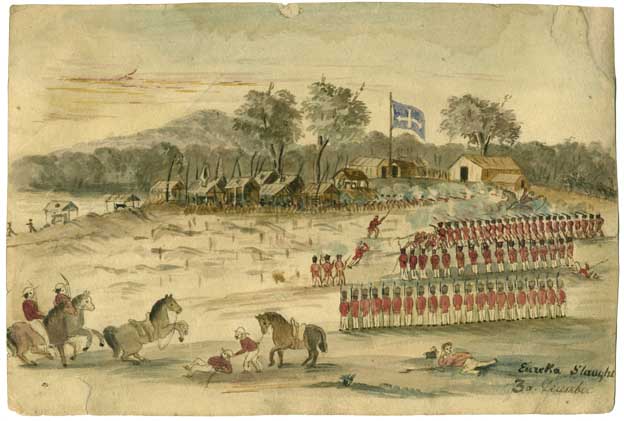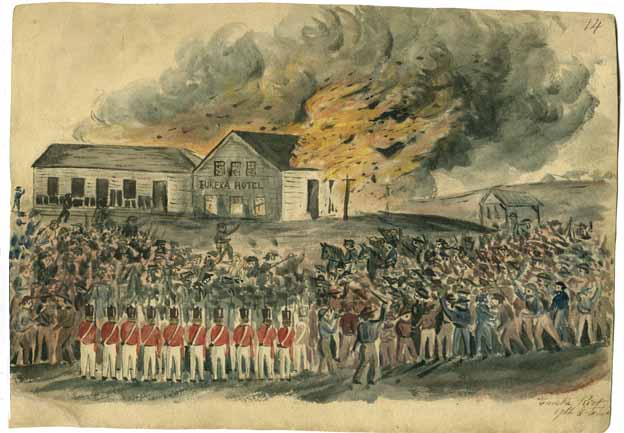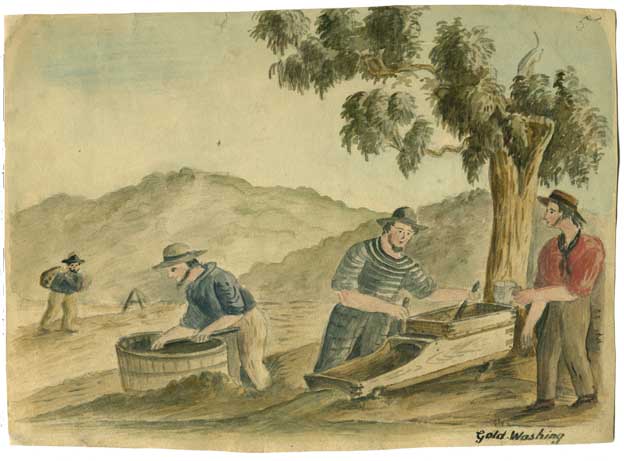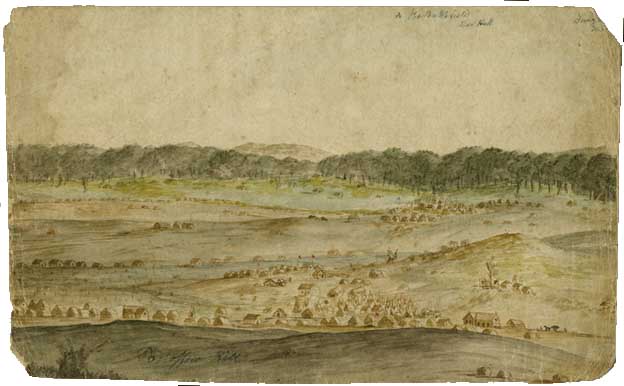Difference between revisions of "Globalisation through digital Experience"
Dottigee16 (talk | contribs) |
Dottigee16 (talk | contribs) |
||
| Line 1: | Line 1: | ||
| + | [[File:1996.61 - Doudiet - The Eureka Battle (Eureka Slaughter 3rd December)-wiki.jpg|1000px|thumb|centre|Charles A. Doudiet, ''Eureka Slaughter 3rd December,'' 1854, watercolour, pen and ink on paper. <br>Courtesy Art Gallery of Ballarat, purchased by the Ballarat Fine Art Gallery with the assistance of many donors, 1996.]] | ||
| + | |||
| + | |||
| + | [[File:1996.59 - Doudiet - Eureka Riot 17th Octobe-wikir.jpg|1000px|thumb|right|Charles A. Doudiet, '' Eureka Riot 17th Octobe,'' 1854, watercolour, on paper. <br>Courtesy Art Gallery of Ballarat, purchased by the Ballarat Fine Art Gallery with the assistance of many donors, 1996.]] | ||
| + | |||
| + | |||
| + | [[File:1996.63 - Doudiet - Gravel Pits Ballarat-wiki.jpg|1000px|thumb|right|Charles A. Doudiet, ''Gravel Pits Ballarat,'' 1854, watercolour, pen and ink on paper. <br>Courtesy Art Gallery of Ballarat, purchased by the Ballarat Fine Art Gallery with the assistance of many donors, 1996.]] | ||
| + | |||
| + | |||
| + | [[File:1996.69 - Doudiet - Gold Washing (Cradling and Puddling)-wiki.jpg|1000px|thumb|right|Charles A. Doudiet, ''Gold washing (Cradling and Puddling,'' 1854, watercolour and on paper. <br>Courtesy Art Gallery of Ballarat, purchased by the Ballarat Fine Art Gallery with the assistance of many donors, 1996.]] | ||
| + | |||
| + | |||
| + | [[File:DOUDIET Charles - Swearing allegiance - 1996.60-wiki.jpg|1000px|thumb|right|Charles A. Doudiet, ''Swearing Allegiance to the 'Southern Cross’,'' 1854, watercolour, pen and ink on paper. <br>Courtesy Art Gallery of Ballarat, purchased by the Ballarat Fine Art Gallery with the assistance of many donors, 1996.]] | ||
| + | |||
| + | |||
| + | [[File:1996.62 - Doudiet - The Battlefield - Red Hill wiki.jpg|1000px|thumb|right|Charles A. Doudiet, ''The Battlefield - Red Hill (From Post Office Hill)'', 1854, watercolour, pen and ink on paper.<br>Courtesy Art Gallery of Ballarat, purchased by the Ballarat Fine Art Gallery with the assistance of many donors, 1996.]] | ||
| + | |||
| + | |||
| + | [[File:1996.65 - Doudiet - The Old Tent (Specimen Hill)-wiki.jpg|1000px|thumb|right|Charles A. Doudiet, ''The Old Tent - BALLARAT (Specimen Hill (Tents), circa 1854, watercolour, pen and ink on paper. <br>Courtesy Art Gallery of Ballarat, purchased by the Ballarat Fine Art Gallery with the assistance of many donors, 1996.]] | ||
| + | |||
Revision as of 12:34, 3 May 2024
by Dr Dorothy Wickham & Clare Gervasoni
Chapter from Pay Dirt: Ballarat & Other Gold Towns BHS Publishing, 2019.
Spawned from enlightened ideals, the Eureka event of 1854 remains a local, national and global experience. This Eureka wiki (See: eurekapedia.org) globalizes the experience of discovering the Eureka story, promotes discussion amongst a wide audience, assists research and interpretation of vital contested questions, digitally preserves memories, experiences and artefacts, allows and promotes access to a wide variety of sources, and consolidates information into one site. The information generated from the statistics of such digital technology clearly shows its significance (over 6 million views). [in 2024 this has risen to over 10 million views.] The wiki has the potential to be used to assist the promotion of the central goldfields of Victoria and consolidate the central goldfields of Victoria as a future World Heritage Site.
The struggle for justice and equality on the Eureka Gold Diggings that culminated early one Sunday morning on 3 December 1854 was one in which many religions, nationalities and personalities united. The issues surrounding Eureka, justice, liberty and freedom, drew together foreigners and British citizens in a common cause. Contemporary comment from the Royal Commission into the Gold Fields 1854-55 observed that ‘The share borne by foreigners in this outbreak has been the subject of frequent comment and been rather variously represented’.
James Madden fifty years after the Eureka Affair wrote that:
... I say, from an intimate knowledge of events, that Englishmen, Irishmen, Scotchmen, and men from other European countries, fought together and so did men of every religion. My family are Ulster-Protestants, and the latter are not usually weak in their faith, and we had many friends, also strict Irish Protestants, who fought and died side by side-with men of all other creeds; among them Irish Catholics. The struggle was one in which all religions united, so great was the oppression; and so strong was the desire to gain for Australia the freedom we have to-day.[2]
A century after the Eureka affair, historian and member of the centenary committee, L.G. Churchward, observed that : ‘The role of foreigners in the Eureka Stockade has been the subject of debate from the eve of the rebellion right up to the present’. Churchward thought that many historians had been influenced by the view that the rebellion was ‘un-British’ such that ‘honest British miners’ must have been led astray by ‘foreign agitators’.
The foreign element of Eureka is still to be explored in full. Authors like John Moloney, Anne Beggs Sunter, Jack Harvey, Bob O’Brien, Joe Toscano, Paul Pickering, and many others have told the stories, or entered the debate, adding to the knowledge and interpretations surrounding the event in various ways. Peter Fitzsimons and Clare Wright have recently contributed to the colour and intrigue of the story, bringing it into the realm of the general history reader. With this ongoing interest in Eureka it is hoped that the eurekapedia will be a useful avenue of research for future generations.
Evaluation of interest in the event through the innovative and fluid technology of a wiki demonstrates Eureka’s importance to heritage tourism and beyond. The statistical analysis built into the site allows a comparative analysis since the wiki’s inception in 2013.
On 21 April 2018 the wiki had nearly six million views. The number of views is rising exponentially as family historians, academics and those interested in the event search the internet. In September 2017 there were over five million views attesting the rich sources of information found in the eurekapedia wiki’s 3645 pages. Pages, photographs, images, newspaper articles and biographies continue to increase, adding to the interest and discourse surrounding the event. From a few hundred pages in 2013, the eurekapedia wiki now comprises nearly 4000 pages, and at the present rate of growth will have had more and more use worldwide.
The eurekapedia was the brainchild of Ballarat Heritage Services, namely Clare Gervasoni and Dorothy Wickham. They had already created a database of those associated with Eureka (1996), the Eureka Research Directory (19980), published the award-winning The Eureka Encyclopaedia (2004), and Women of the Diggings (2009), as well as participating in the ABC open broadcast on the 150th anniversary of Eureka.
These enterprising women believed that the story of Eureka was paramount in the national psyche, should be accessible to a world-wide audience, and that the discussions about the many controversies associated with the event should be aired in a forum where each point of view could be heard. What better vehicle than a Wikipedia to have such a fluid creative informative platform, and one that continues to grow and have permanence?
In March 2013 moves to develop the Eurekapedia wiki were discussed between Ballarat Reform League Inc. and Ballarat Heritage Services. Eurekapedia is hosted by the Ballarat Reform League Inc., with Clare Gervasoni and Dorothy Wickham (Ballarat Heritage Services) developing and maintaining the fully referenced content pages.
This wiki is a community project, with valued contributions and support. The assistance of the Art Gallery of Ballarat, Ballarat Heritage Services, Ballarat Reform League Inc., Federation University, Gold Museum, Old Colonists' Association of Ballarat, Public Record Office Victoria, The Vera Moore Foundation and many other individuals and entities who have contributed in so many different and helpful ways is gratefully acknowledged. All images are published with permission, and credits published in close proximity to the image. Where images come from collections they are also listed under the Collections heading. Contributions (including references) may be sent to eurekapedia@yahoo.com.au, and may be published in the wiki after review. Contributors are acknowledged and transcriptions from for example, Christine Stancliffe, another Eureka buff, are written in the referencing section of the article or newspaper clipping that has been transcribed.
Combined with comparative interpretations, eyewitness accounts, biographies, and contemporary essays, this digital technology allows new avenues for enquiry and contemplation. Wickham and Gervasoni are currently examining the role of foreigners at Eureka by searching prosopological avenues on the wiki. Allowing for new interpretations, Wickham has also placed Eureka in an unusual global setting, showing the links between Guiseppe Garibaldi, George Jacob Holyoake and Eureka. With excerpts of the chapter being part of the eurekapedia wiki, comments and discussion are always welcome.
The wiki is constantly evolving and expanding so that it is impossible to claim that it is “absolute”. Because of the new information being unearthed and collated consistently and almost daily, the wiki is never “finished” but always expanding. For example, one foreigner known only as ‘Romeo’ until recently, has been named as Le Fronzis Romeo, due to in-depth research by Yvon Davis who kindly provided the information to the eurekapedia. Yvon also provided information about Dutch national Jan Vennik, a foreigner tried for Treason. The fully referenced eurekapedia wiki where this research can be found, is one of the most comprehensive tools for the study of the Eureka event, bringing to the surface issues that have remained hidden for years.
The eurekapedia wiki offers the main themes of Eureka providing insight into little known aspects of the event. It investigates events prior, during and after the Eureka battle of 3 December 1854. It delivers a Eureka Timeline and Essays on some very interesting and controversial points of difference. This project unlocks the stories of "ordinary" people, places and multicultural beginnings in the 1850s that resulted in extraordinary outcomes and reforms. Goldfields agitation, the Diggers Oath, and the Ballarat Reform League Charter contributed to the very fabric of Australian identity and the "Birthplace of the Australian Spirit".
Eurekapedia provides information on the people and stories that lie parallel to the development of Australian democracy and culture. The significant narratives of goldfields agitation, the Ballarat Reform League, and the events leading to the battle at the Eureka Stockade, the only civil uprising on Australian soil, are central to the development of Australia as a democratic country. The men and women involved in the Ballarat Reform League, Red Ribbon Rebellion, and like organisations are important associations in the story of Eureka and significant in our national identity.
The often interlinking stories of the people associated with the Eureka Stockade are readily accessible through the technology of this interactive wiki format on the world wide web. This platform allows researchers to seek the ships, origins and abodes ancestors are associated with, often finding fellow passengers or relatives. Migration patterns and multicultural associations can often be explored and extended by the use of such an interactive source.
The digital technology that created the eurekapedia has already had a significant impact on the story of Eureka, in that it provides linkages, and information quickly and easily. It could be utilised to entice a world-wide audience to visit a heritage site such as Eureka. Such technology is being used by schools and educators to inform and teach their students. It has already led to school visits to the site and opened further learning through scholastic discussion groups. It could be used to entice family historians to the central goldfields of Victoria to search for the places in which their ancestors dug for gold, so bringing a wider economic benefit. The opportunities are endless, and given extra resources, the eurekapedia wiki could be used to promote the central goldfields of Victoria as a World Heritage Site.
The eurekapedia wiki has been produced by two women, outside their normal working hours, to promote their interests and ideals and the enlightened views of Eureka. They have been facilitated by the Ballarat Reform League Inc. a small group of people dedicated to the promotion of Eureka. Wickham and Gervasoni have spent years researching Eureka (both in Australia and overseas), written many books on the subject, created databases of names associated with the event, and contributed significantly to the discourse and interpretation of the event. They have been supported by the wider community and assisted by them, having been given freely the use of photographs and information. They are eternally grateful for the help they have received from the “ordinary” (perhaps I should say “extraordinary”) people from all over the world. They received no council or government funding for The Eureka Encyclopaedia on the 150th anniversary of Eureka, a publication that is one of the true permanent reminders of the commemoration, the importance of the Eureka event, and its place in the global space of world heritage.
The eurekapedia wiki is an important contribution to the study of the Eureka Event making information about, and names associated with, Eureka freely and easily accessible worldwide. It is a platform that clearly promotes discussion, interpretation and healthy discourse. Memories and stories, as well as images are digitally recorded, preserved and referenced, so that the wiki provides a collection conserved digitally for the future. Because of the wide variety of sources and the consolidation of information on the one site, plus the ability to link sources, the eurekapedia wiki promotes and facilitates research. With nearly six million views to date, the eurekapedia wiki illustrates that there is much interest in the event, that this interest is growing, and also that it is a most significant platform providing a global experience of discovery.






